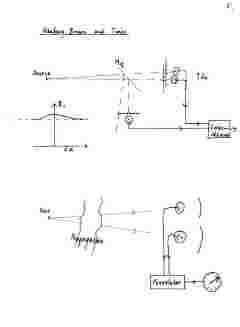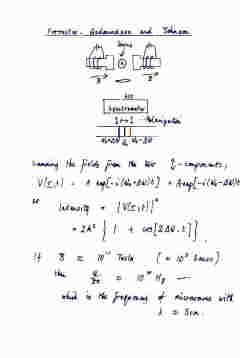|
In the mid-1950s two very remarkable experiments were reported - one by R. Hanbury Brown and R. Q. Twiss, working at Jodrell Bank; and the other by A. T. Forrester, Gudmundsen and Johnson, in USA. Both could be interpreted, up to a point, in terms of coherence; but since the use of fast photo-electric detectors was crucial to both experiments, it was felt that "a fuller analysis ... must take into account the quantum nature of the photo-electric process." At this point people who felt that the quantum nature of the photo-electric effect could be taken into account by talking about 'photons' got themselves into terrible muddles - and, very often, bad tempers.
|
|
The Hanbury-Brown and Twiss experiment
What is measured in this experiment is the correlation between the intensities at two different points in the field produced by a small source. It turns out that this correlation can be expressed in terms of the mutual intensity at these two points, and the existence of this correlation is perfectly intelligible in wave terms (R H B and R Q T had previously performed the experiment at radio frequencies, and it is done with sound waves in some university U/G laboratory classes!). But if you do the experiment with photo-multipliers and look for coincidences between the detection of 'photons' at the two cathodes you have great difficulty explaining why 'photons' do or don't 'arrive' simultaneously at the two detectors - particularly if you have a beam-splitting mirror in the system. Indeed, the distinguished Hungarian physicist L. Janossy suggested that the effect probably doesn't exist, and that if it does "this will require fundamental modifications in quantum theory". |
|
The Forrester-Gudmundsen-Johnson experiment
It was possible to create difficulties in understanding this one if you said : the 'photons' with frequencies w0+D and w0-D must have been emitted by different atoms, so how could they interfere? |
|
About both experiments, some people said the reported results were obviously impossible. (Recall that at the British Association in 1876 Kennelly and Heaviside defended themselves from attacks in the words :
"they said our statements were impossible, to which we made reply that we had not said that they were possible, but only that they were true"! )
It's a simple-minded view of a 'photon' which suggests that it contains only one frequency; and it's a ludicrously naive view of a light field which regards it as a hailstorm of photons. The only way to construct a photon-picture of these experiments is to look for some theoretical picture which does explain them, and then design 'photons' which contain the essential features of the satisfactory explanation. What is it that we (but count me out!) want the photons for? Simply to embody the notion that matter exchanges energy with radiation fields in discrete amounts. But the propagation of the field - and of its coherence properties - is a wave process, and the wave-features must figure prominently in any quantum theory of optical phenomena. |

